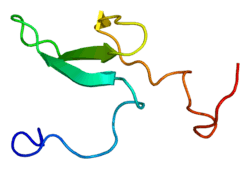Function
Function may refer to:
Math, computing and engineering
Music
Other uses
See also

Minkowski's question mark function
In mathematics, the Minkowski question mark function (or the slippery devil's staircase), denoted by ?(x), is a function possessing various unusual fractal properties, defined by Hermann Minkowski (1904, pages 171–172). It maps quadratic irrationals to rational numbers on the unit interval, via an expression relating the continued fraction expansions of the quadratics to the binary expansions of the rationals, given by Arnaud Denjoy in 1938. In addition, it maps rational numbers to dyadic rationals, as can be seen by a recursive definition closely related to the Stern–Brocot tree.
Definition
If ![[a_0; a_1, a_2, \ldots]](http://assets.wn.com/wiki/en/0/ea/7c680f6e729c8d6aae135-7c9257.png) is the continued fraction representation of an irrational number x, then
is the continued fraction representation of an irrational number x, then
whereas:
If ![[a_0; a_1, a_2, \ldots, a_m]](http://assets.wn.com/wiki/en/c/24/c5c87101d277c71663c6f-8f7e6a.png) is a continued fraction representation of a rational number x, then
is a continued fraction representation of a rational number x, then
Intuitive explanation
To get some intuition for the definition above, consider the different ways of interpreting an infinite string of bits beginning with 0 as a real number in [0,1]. One obvious way to interpret such a string is to place a binary point after the first 0 and read the string as a binary expansion: thus, for instance, the string 001001001001001001001001... represents the binary number 0.010010010010..., or 2/7. Another interpretation views a string as the continued fraction [0; a1, a2, … ], where the integers ai are the run lengths in a run-length encoding of the string. The same example string 001001001001001001001001... then corresponds to [0; 2, 1, 2, 1, 2, 1, …] = √3 − 1/2. If the string ends in an infinitely long run of the same bit, we ignore it and terminate the representation; this is suggested by the formal "identity":

Structural functionalism
Structural functionalism, or simply functionalism, is a framework for building theory that sees society as a complex system whose parts work together to promote solidarity and stability. This approach looks at society through a macro-level orientation, which is a broad focus on the social structures that shape society as a whole, and believes that society has evolved like organisms. This approach looks at both social structure and social functions. Functionalism addresses society as a whole in terms of the function of its constituent elements; namely norms, customs, traditions, and institutions. A common analogy, popularized by Herbert Spencer, presents these parts of society as "organs" that work toward the proper functioning of the "body" as a whole. In the most basic terms, it simply emphasizes "the effort to impute, as rigorously as possible, to each feature, custom, or practice, its effect on the functioning of a supposedly stable, cohesive system". For Talcott Parsons, "structural-functionalism" came to describe a particular stage in the methodological development of social science, rather than a specific school of thought. The structural functionalism approach is a macrosociological analysis, with a broad focus on social structures that shape society as a whole.

WWOX
WW domain-containing oxidoreductase is an enzyme that in humans is encoded by the WWOX gene.
Function
WW domain-containing proteins are found in all eukaryotes and play an important role in the regulation of a wide variety of cellular functions such as protein degradation, transcription, and RNA splicing. This gene encodes a protein which contains 2 WW domains and a short-chain dehydrogenase/reductase domain (SRD). The highest normal expression of this gene is detected in hormonally regulated tissues such as testis, ovary, and prostate. This expression pattern and the presence of an SRD domain suggest a role for this gene in steroid metabolism. The encoded protein is more than 90% identical to the mouse protein, which is an essential mediator of tumor necrosis factor-alpha-induced apoptosis, suggesting a similar, important role in apoptosis for the human protein. In addition, there is evidence that this gene behaves as a suppressor of tumor growth. Alternative splicing of this gene generates transcript variants that encode different isoforms.
Podcasts:

